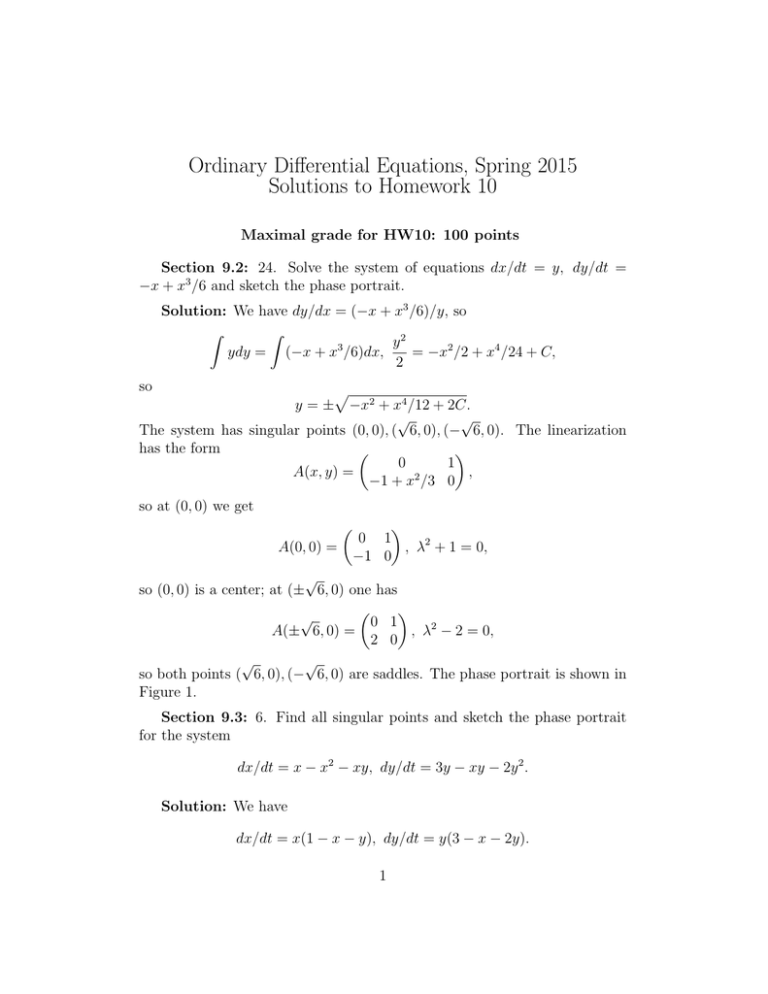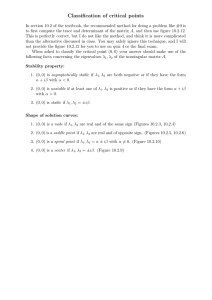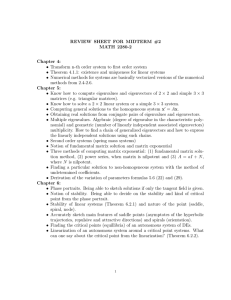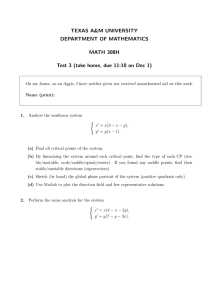Ordinary Differential Equations, Spring 2015 Solutions to Homework
advertisement

Ordinary Differential Equations, Spring 2015 Solutions to Homework 10 Maximal grade for HW10: 100 points Section 9.2: 24. Solve the system of equations dx/dt = y, dy/dt = −x + x3 /6 and sketch the phase portrait. Solution: We have dy/dx = (−x + x3 /6)/y, so Z Z y2 ydy = (−x + x3 /6)dx, = −x2 /2 + x4 /24 + C, 2 so p −x2 + x4 /12 + 2C. √ √ The system has singular points (0, 0), ( 6, 0), (− 6, 0). The linearization has the form 0 1 A(x, y) = , −1 + x2 /3 0 y=± so at (0, 0) we get A(0, 0) = 0 1 , λ2 + 1 = 0, −1 0 √ so (0, 0) is a center; at (± 6, 0) one has √ 0 1 A(± 6, 0) = , λ2 − 2 = 0, 2 0 √ √ so both points ( 6, 0), (− 6, 0) are saddles. The phase portrait is shown in Figure 1. Section 9.3: 6. Find all singular points and sketch the phase portrait for the system dx/dt = x − x2 − xy, dy/dt = 3y − xy − 2y 2 . Solution: We have dx/dt = x(1 − x − y), dy/dt = y(3 − x − 2y). 1 There are four different cases for singular points: (a) x = 0, y = 0; (b) x = 0, 3 − x − 2y = 0, so y = 3/2; (c) y = 0, 1 − x − y = 0, so x = 1; (d) 1 − x − y = 0, 3 − x − 2y = 0, so y = 2, x = −1. The singular points are (0, 0), (0, 3/2), (1, 0), (−1, 2). The linearization has the form 1 − 2x − y −x A(x, y) = , −y 3 − x − 4y so at (0, 0) we get 1 0 A(0, 0) = , (λ − 1)(λ − 3) = 0, 0 3 so the eigenvalues are λ1 = 1, λ2 = 3 and (0, 0) is an unstable node; at (0, 3/2) we get −1/2 0 A(0, 3/2) = , (λ + 1/2)(λ + 3) = 0, −3/2 −3 so the eigenvalues are λ1 = −1/2, λ2 = −3 and (0, 3/2) is a stable node; at (1, 0) we get −1 −1 A(1, 0) = , (λ + 1)(λ − 2) = 0, 0 2 so the eigenvalues are λ1 = −1, λ2 = 2 and (1, 0) is a saddle point; at (−1, 2) we get 1 1 A(−1, 2) = , (λ − 1)(λ + 4) + 2 = λ2 + 3λ − 2 = 0, −2 −4 √ so the eigenvalues are λ1,2 = −3±2 17 and (−1, 2) is a saddle point. The phase portrait is shown in Figure 2. 7. Find all singular points and sketch the phase portrait for the system dx/dt = 1 − y, dy/dt = x2 − y 2 . Solution: We have y = 1, x2 = y 2 = 1, so x = ±1. The linearization has the form 0 −1 A(x, y) = , 2x −2y 2 so at (−1, 1) we get A(−1, 1) = 0 −1 , λ(λ + 2) − 2 = λ2 + 2λ − 2 = 0, −2 −2 √ √ the eigenvalues are λ1,2 = −2±2 12 = −1 ± 3, so (−1, 1) is a saddle point; at (1, 1) we get 0 −1 A(1, 1) = , λ(λ + 2) + 2 = λ2 + 2λ + 2 = 0, 2 −2 √ the eigenvalues are λ1,2 = −2±2 −4 = −1±i, so (−1, 1) is a stable spiral point. The phase portrait is shown in Figure 3. 19. Solve the nonlinear system and its linearization at (0, 0) and sketch the corresponding phase portraits: dx/dt = y, dy/dt = x + 2x3 . Solution: The linearized system has the form x0 = y, y 0 = x, so dy/dx = x/y, Z Z ydy = xdx, y 2 /2 = x2 /2 + C. Similarly, for the nonlinear system we have Z Z ydy = (x + 2x3 )dx, y 2 /2 = x2 /2 + x4 /2 + C. The matrix of the linearlized system equals 0 1 , 1 0 it has eigenvalues λ1 = 1, λ2 = −1, and eigenvectors v1 = (1, 1) and v2 = (−1, 1) (so this is a saddle point) The phase portraits for both systems are shown in Figure 4. 20. Solve the nonlinear system and its linearization at (0, 0) and sketch the corresponding phase portraits: dx/dt = x, dy/dt = −2y + x3 . 3 Solution: The linearized system has the form x0 = x, y 0 = −2y, so we get x = Aet , y = Be−2t , and (0, 0) is a saddle point. In the nonlinear system, we can still write x = Aet , so y 0 + 2y = A3 e3t . We can look for a special solution of this nonhomogeneous linear equation in the form y = Be3t , then y 0 = 3Be3t , and y 0 + 2y = 3Be3t + 2Be3t = A3 e3t ⇒ B = A3 /5. 3 Therefore the general solution is y(t) = A5 e3t + Ce−2t . For C = 0, we get y = x3 /5. The phase portraits for both systems are shown in Figure 5. 4 4 2 0 -2 -4 -4 -2 0 2 Figure 1: Graph for problem 24 5 4 4 2 0 -2 -4 -4 -2 0 2 Figure 2: Graph for problem 6 6 4 4 2 0 -2 -4 -4 -2 0 2 Figure 3: Graph for problem 7 7 4 4 4 2 2 0 0 -2 -2 -4 -4 -4 -2 0 2 4 -4 -2 0 2 4 0 2 4 Figure 4: Graph for problem 19 4 4 2 2 0 0 -2 -2 -4 -4 -4 -2 0 2 4 -4 -2 Figure 5: Graph for problem 20 8





